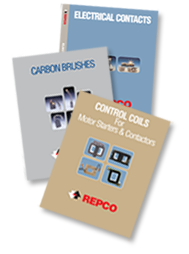
- Electrical Contacts
- Carbon Brushes
Carbon Brushes : Brush Reference
- Control Coils
Control Coils
- Other Contactor Parts
- More
- Search
- Auxiliary Contacts
Auxiliary Contacts
- Shunts
Shunts
- Springs
Springs
- ContactorsDC
ContactorsDC
- Fuses
By: Repco Inc
A Beginner’s Guide to DC Motors
From excavators and elevators to vacuum cleaners and remote-controlled quadcopters, Direct Current (DC) motors are utilized by countless industries and individuals on a routine basis.Want to learn more about DC motors? This comprehensive guide covers everything you need to know about DC motors, including how they work, some common applications, and the various types of DC motors that are used in industrial and consumer-grade technology.
What is a DC Motor?
DC motors are specialized machines that convert electrical energy, typically from a battery, into mechanical energy. An electrical current flows directly from the power source to the motor, where the energy converts to mechanical rotation. This mechanical rotation is harnessed to spin wheels, propellers, blades, and other components of common machines, tools, and devices.How Does a DC Motor Work?
DC motors work by using their power source to generate electrical currents in the motor’s brush which, in conjunction with the stator magnets, generate magnetic fields. The movement of the rotor is ultimately driven by the magnetic fields generated by the electrically-charged brushes interacting with the stator. The amount of torque and speed generated by the motor will vary depending on the electrical input and the specific type of DC motor being used.
Parts of a DC Motor
The parts of a DC motor may vary depending on the exact type of DC motor, but generally speaking, these are the parts you can expect to find in a typical DC motor:
- Axel: Holds the armature and commutator.
- Armature: A series of electromagnets that carry the electrical current.
- Commutator: Enables electricity to flow to the armature.
- Stator Magnets: Generate rotating magnetic field for the armature.
- Brushes: Work with the commutator to ensure proper direction of current/rotation.
Different Types of DC Motors & Their Applications
There are four different types of DC motors commonly used in industrial and consumer grade equipment and products. Each type has strengths and drawbacks when compared to the others, and the type of DC motor being used is going to vary depending on the specific application.The 4 Main Types of DC Motor
Permanent Magnet DC Motor: This type of DC motor uses permanent magnets, as opposed to electromagnets, to provide a magnetic field for the rotor field to interact with in order to generate torque. Permanent magnet DC motors have great starting torque and speed regulation.
Common Applications: Windshield wipers, power window mechanisms, blowers, heaters, air conditioners, computer drives, toys, electric toothbrushes, food mixers, power tools.
Shunt DC Motor: Same general assembly as the other types of DC motors; shunt DC motors use a stator (or field windings), a commutator, and an armature (or a rotor). Shunt DC motors are able to maintain a constant speed, regardless of how the load on the motor changes — this makes shunt DC motors an ideal choice when precise speed regulation is needed.
Common Applications: Weaving machines, centrifugal pumps, conveyor belts, mixers, lifts.
Series DC Motor: Series DC motors have larger conductors in their stator/windings, giving them very minimal resistance and allowing them to receive a considerably larger power supply. The main drawback of series DC motors is that heavy loads have a major impact on speed.
Common Applications: In airplanes they are used to control the wings and cowl, and to start the engine; also commonly found as engine starters for automobiles. Other applications include winches, hoists, vacuum cleaners, and small/portable electrical appliances.
Compound DC Motor: Compound DC motors are very versatile, providing essentially all the advantages you get from series and shunt motors. However, compound DC motors also have disadvantages, such as their maintenance requirements and the cost of proper maintenance.
Common Applications: Elevators, printing presses, punching presses, stamping presses, shears, steel rolling mills, industrial mixers, cutting machines.
How Frequently Do You Use DC Motors?
It’s clear that DC motors are extremely commonplace, but perhaps undersung pieces of technology that people around the world rely on practically every day. How often do you depend on DC motors during your daily routine? At Repco, we’re proud to provide brushes and shunts that are used in industrial motors and control equipment — contact us to learn more!
Literature Request Or Download
Request our Electrical Contact, Carbon Brush, or Control Coil catalogs. Or download PDFs or browse them online.
Choose

Repco
100 Sonwil Drive
Buffalo NY 14225 - Control Coils